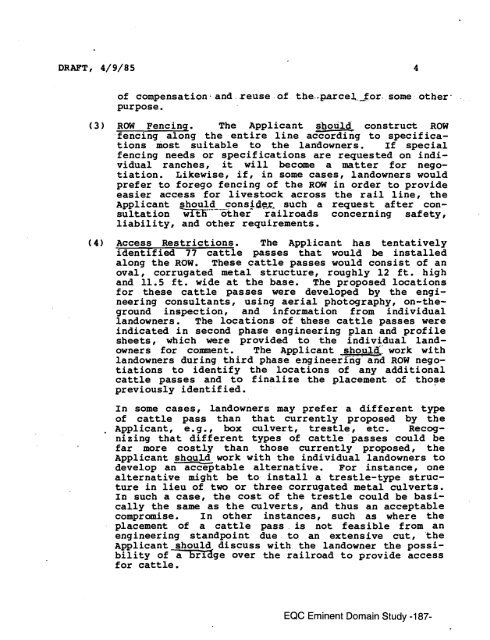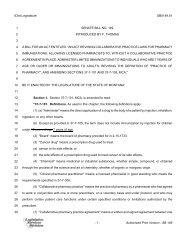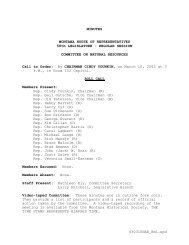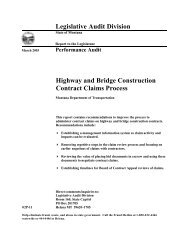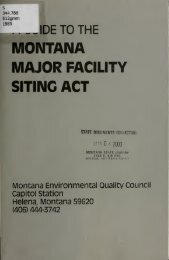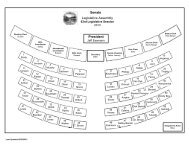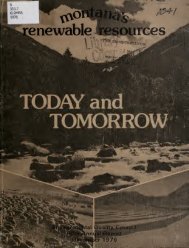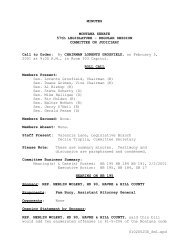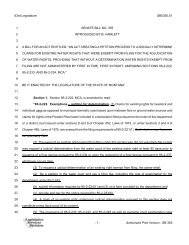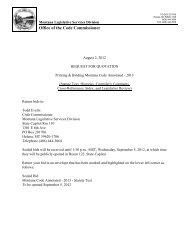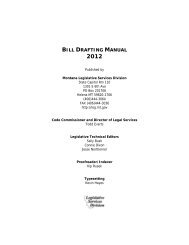Public Comment. Volume III - Montana Legislature
Public Comment. Volume III - Montana Legislature
Public Comment. Volume III - Montana Legislature
Create successful ePaper yourself
Turn your PDF publications into a flip-book with our unique Google optimized e-Paper software.
DRAFT, 4/9/85 4<br />
of compensation. and reuse of the.-parcel.for. some other -<br />
purpose.<br />
(3) ROW Fencing. The Applicant shoulk construct ROW<br />
fencing along the entire line according to specifications<br />
most suitable to the landowners. If special<br />
fencing needs or specifications are requested on individual<br />
ranches, it will become a matter for negotiation.<br />
Likewise, if, in some cases, landowners would<br />
prefer to forego fencing of the ROW in order to provide<br />
easier access for livestock across the rail line, the<br />
Applicant should cons$de.r4 such a request after consultation<br />
='---other railroads concerning safety,<br />
liability, and other requirements.<br />
( 4) Access Restrictions. The Applicant has tentatively<br />
identified 77 cattle passes that would be installed<br />
along the ROW. These cattle passes would consist of an<br />
oval, corrugated metal structure, roughly 12 ft. high<br />
and 11.5 ft. wide at the base. The proposed locations<br />
for these cattle passes were developed by the engineering<br />
consultants, using aerial photography, on-theground<br />
inspection, and information from individual<br />
landowners. The locations of these cattle passes were<br />
indicated in second phase engineering plan and profile<br />
sheets, which were provided to the individual landowners<br />
for comment. The Applicant shou/t]l: work with<br />
landowners during third phase engineerfig- and ROW negotiations<br />
to identify the locations of any additional<br />
cattle passes and to finalize the placement of those<br />
previously identified.<br />
In some cases, landowners may prefer a different type<br />
of cattle pass than that currently proposed by the<br />
. Applicant, e.g., box culvert, trestle, etc. Recognizing<br />
that different types of cattle passes could be<br />
far more costly than those currently proposed, the<br />
Applicant shou~work with the individual landowners to<br />
develop an acceptable alternative. For instance, one<br />
alternative might be to install a trestle-type structure<br />
in lieu of two or three corrugated metal culverts.<br />
In such a case, the cost of the trestle could be basically<br />
the same as the culverts, and thus an acceptable<br />
compromise. In other instances, such as where the<br />
placement of a cattle pass is not feasible from an<br />
engineering standpoint due to an extensive cut, the<br />
Applicant should discuss with the landowner the possibility<br />
of h-brTdge over the railroad to provide access<br />
for cattle.<br />
EQC Eminent Domain Study -1 87-


